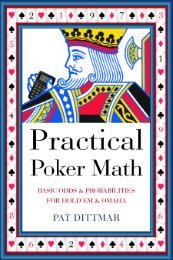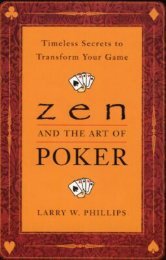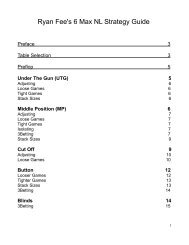You also want an ePaper? Increase the reach of your titles
YUMPU automatically turns print PDFs into web optimized ePapers that Google loves.
128<br />
First of all, the above calculation assumes we have 100% equity<br />
when we flop a set. This is certainly not the case. When most<br />
sane opponents want to get a lot of money in on the flop, they’re<br />
normally going to have something they like. Maybe they<br />
flopped a flush draw, and you have 75% equity. Maybe they<br />
flopped a straight, and you have 35% equity. In fact, you may<br />
be drawing to one out if someone flopped a bigger set. The point<br />
is, you do not have 100% equity.<br />
Let’s say you have 3♥3♠ and call a $1 preflop raise from your<br />
opponent who started with $8. You flop 3♦7♠Q♦, and your<br />
opponent gets all-in with his K♦K♥. Your opponent has 13%<br />
equity. Here’s your flop EV getting all-in.<br />
0.87($7) + 0.13(-$7) = EV<br />
$6.09 - $0.91 = $5.18<br />
This is more than $1 short of what we needed to get postflop.<br />
However, it’s one of the best situations we can expect to get<br />
postflop. Let’s say that our average equity when we get all-in<br />
postflop against a sane opponent is 80%. This number will<br />
change depending on the types of hands with which your<br />
opponent will put in the rest of his money. Looser players may<br />
be willing to get their money in the middle with much worse<br />
equity on average than more timid players. However, let’s use<br />
this 80% as an example. How much money would our opponent<br />
have to have in his stack?<br />
0.80(x) + 0.20(-x) > $6.33<br />
0.80x – 0.20x > $6.33<br />
0.60x > $6.33<br />
x > $10.55









